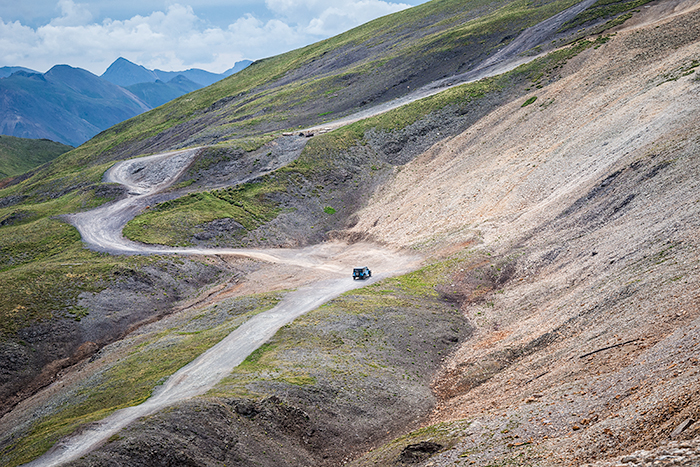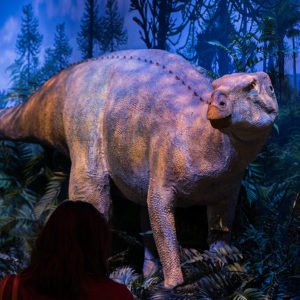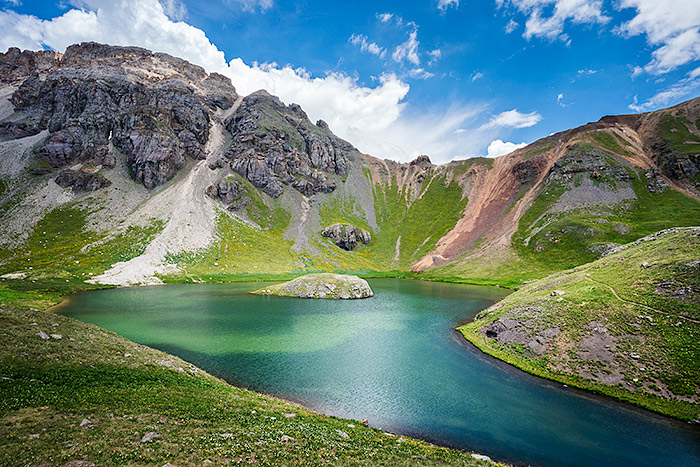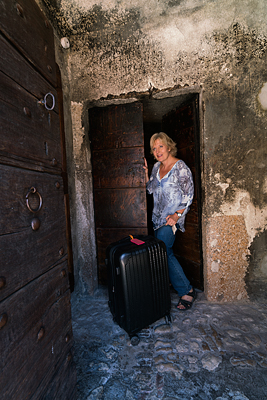
 Thrilling adventures. Epic scenery. Outdoor options galore!
Thrilling adventures. Epic scenery. Outdoor options galore!
Colorado is a stunning state. And a massive one at that—with more mountain passes to slow you down than you might think. In this post find out my Colorado travel planning tips for customizing an itinerary and saving money along the way!
Let’s start with a broad overview of the different regions. Where do you want to go?
REGIONS:
Northwest

 The Continental Divide cuts through some of the highest, snow-covered peaks in the Rockies. So naturally some of the most popular ski resorts are located here: Vail, Aspen, Snowmass, Breckenridge and Winter Park. Drive further west, and see massive dinosaur bones lying in situ in the enormous clay fossil beds dating from the Jurassic era at Dinosaur National Monument. Grand Junction is the biggest city here.
The Continental Divide cuts through some of the highest, snow-covered peaks in the Rockies. So naturally some of the most popular ski resorts are located here: Vail, Aspen, Snowmass, Breckenridge and Winter Park. Drive further west, and see massive dinosaur bones lying in situ in the enormous clay fossil beds dating from the Jurassic era at Dinosaur National Monument. Grand Junction is the biggest city here.
Southwest


Island Lake near Silverton
Black Canyon near Gunnison is the gateway to the southwest where small historic towns with faded Victorian architecture sit in the midst of San Juan Mountain peaks, like Ouray, Silverton, Ridgway & Telluride. Directly south is larger Durango and further west, the cliff dwellings at Mesa Verde National Park. Hiking, skiing, rafting, backpacking are very popular here. (And my favorite region I must admit!)
Central


South Central


Northeast
Southeast
Grasslands sway in this Great Plains landscape, but tourists driving toward Canon City get a big surprise. The narrow Royal Gorge plummets 1053 feet deep. At this popular attraction visitors can test their vertigo swinging over the edge, ziplining or climbing iron rungs on their new Via Ferrata.
ACTIVITIES:
What’s compelling you to visit?


Hiking along the Continental Divide
The lure of the mountains? Epic hikes along the Continental Divide? Rafting? Fishing? Dinosaur fossils?
Poking around historic mining towns wind-battered into tattered ghost towns?


Animas Forks Ghost Town
Riding Jeeps or 4-wheeling over high mountain passes?
Climbing ladders to wander where the Ancient Ones once lived?
Skiing? Mountain biking? Rock climbing (like this guy in Durango)?


Soaking in hot springs? Staying on a dude ranch? Canyoneering? Or camping under stars?


Whew, I know…there’s so much to do! The options are hard to narrow down for those of us who love the outdoors!
So where DO you begin?
Research
Personally, I always begin planning the old-fashioned way. Reading guide books.
Lots of them. Brands vary. Lonely Planet has good info for budget backpackers. Moon, Fodors, Frommers have budget and splurge worthy ideas. Bradt goes more in-depth. Insight Guides has large full-color photos, maps and interesting back stories and history. I buy several. Then read them cover to cover for an overview of the state, highlighting the regions and activities that impress as I blast past. My books are a mess because I underline, circle, star pages or write little side notes as they pop into my head.
Reading helps narrow down the regions that sound the most appealing. Then I go online, searching for ideas based on specific locations or keep focused on specific activities.
For example, take hiking. I might search for Colorado’s best day hikes, guided overnight hiking trips, or Google llama trekking trips. Or check All Trails website for hiking ideas in a particular region like the San Juan Mountains. Blogs, trip reports, and tour operators are all great resources for inspiration and information. Searching for images is also a great way to narrow down choices.


Hiking to Ice Lake
When I googled Colorado’s best hiking trails and saw pictures of Ice Lake, I knew instantly that I had to figure out a way to include that hike in my itinerary!
Selecting your “Special”
Once you’ve finished reading and researching online, try narrowing the choices down to ONE SPECIAL ACTIVITY. What one thing stands out that would be super cool to do? Maybe something a little intimidating that you’ve never considered before. Something a little out of your comfort zone. Something unique!
When planning my trip to Colorado, there were many places and activities that intrigued me. But one kept resurfacing and rolling around my curiosities. It was a 5 day guided llama trekking trip in the San Juan Mountains.


I considered the costs. And the chunk of time it would require, as we would need to allow another week to acclimate to those elevations. I wasn’t an experienced backpacker, and hadn’t been camping in a long time. And was a bit nervous about the 12,000 altitude for my daughter. But I woke up thinking about it with increasing excitement. The trip appealed to the hiker/photographer in me big time. Hiking along the Continental Divide and camping in the Weminuche Wilderness meant I could capture the mountains, lakes and wildflowers from sunrise to the Milky Way. And llamas—which my daughter adores—would carry all our gear and the guides would cook for our group. Sounded like a perfect bonding trip for a Mom and her teenage daughter. So, we chose a week and booked it. The llama trekking became our “special.”
What’s yours? What stands out to you? What will you be excited to talk about when you return from your trip?
Branching Out
Once you select your “special,” it’s easier to then plan the rest of your trip accordingly.
If it’s a high altitude activity, you’ll have to consider time to acclimatize. We spent a week hopscotching to higher elevations from Colorado Springs to Silverton. And doing short excursions to test our reaction to 12,000 ft elevations by taking gondola rides, jeep rides and day hikes up into the mountains.


Colorado West jeep tour, Imogene Pass, Ouray
Prioritize the other activities on your wish list from your research. How much time is required for each activity, and is an overnight required? Remember you want to start day hikes early in the morning so you’re off the mountain before early afternoon thunderstorms strike. That means overnighting in the area. Analyze the logistics of the activities to see what won’t be possible based on timing and eliminate those from your list. Plot your preferences out and see where they fall on a Colorado state map. Is there a natural route forming?
Calculate driving times by plugging in cities on Google maps and get an idea how long it takes to drive between the destinations. See what activities you can group together in one region and stay a few nights in one place. I like to sketch out a rough map with destinations and activities written in to “see” how it fits together on a road trip. I also create a written time line to check the flow and feasibility of the activities, careful to balance crazy busy days with mellow days.
WHEN TO GO:
Your chosen activity will determine when you visit. But if it’s not defined, here’s a brief overview of the seasons.
Summer: This season is super short, basically 2 months—early July to the end of August. Temps can reach 100 F at lower elevations and 70-80 F in the mountains during the day, dipping down to the 40’s – 50’s at night. When planning summer hikes, factor in afternoon thunderstorms. Plan predawn departures to get off the mountain around noon. Tragedy strikes all too often from being exposed on open slopes. Expect higher rates and know that limited lodging often becomes unavailable months in advance as tourists hurry to book rooms during Colorado’s busiest season.
Fall/Spring: Good wildlife viewing and fishing. Less expensive time to visit as hotel rates and airfare drop. Spring snows last until June. In fact, March and April produce the most snow—up to 400 inches of snow fall in the southwestern mountains each year. Check the route you’re considering to see if the roads are actually open that time of year.
Winter: November to April. Obviously great for skiing and snowboarding. Travel prices tend to skyrocket over Christmas break.


Air Force Academy, Colorado Springs
FLIGHTS:
Don’t assume that you have to fly into the largest airport, Denver. Or think that you have to book a “round trip ticket” from one airport.
Did you know that you can fly into one city and depart from another? Even when renting a car? Colorado is a perfect place to do this.
Called an “open jaw” ticket, the fly-into-one-airport and fly-out-of-another is easily found by clicking on the “Advanced Search” box on any airline website (like Delta, United, American Airlines) or a search engine such as Google Flights, Kayak, Momondo (which compare several carriers).
Why should you consider this? Because long distances stalled by gorgeous scenery prompting repeated pullovers to appreciate the view, and slippery, curvy mountain passes will most assuredly slow down your road trip. Look at a map and decide what “must see” places you want to include in your trip.
Ideally, where do you want to begin? End? Check out the cost of airfare for airports near that route. Smaller airports are often less expensive because they have less booked seats. (And far less wait time in security lines.) So play with different airport city combinations to find the best fares. Fly into one airport, and leave from another. Save time AND money!
Our example:
We flew into Colorado Springs (central) and departed from Durango (southwest). Saved us from backtracking and adding another 3 days plus gas/lodging/food to return to Colorado Springs. And the airfare and flight time home was the same whether we flew out of either place.
ALTITUDE:
Splitting headaches, nausea, fatigue and insomnia caused from high elevations can wreck havoc on your vacation. Take time to acclimatize! Altitude sickness can kick in around 7,500 ft and affect travelers randomly (even if you’ve never felt symptoms before). Plan to spend a couple days at lower elevation, around 6,000 ft, and arrange your itinerary to climb higher gradually. A general guideline to acclimatize safely and prevent altitude sickness during your trip is to sleep 1-2 nights in a destination for each 1,000 foot elevation gain.
So fly into Colorado Springs, but don’t zip up to the summit of Pike’s Peak the next day! Or fly into Grand Junction, but don’t plan to go skiing in Winter Park tomorrow. Or, fly into Durango, but don’t hike Ice Lake trail up in Silverton for a few days. Pace yourself!!


For trip planning, here are some elevations to help plan your route. Those underlined have airports you could fly into and use as a starting base.
Denver: 5,280 ft.
Estes Park: 7,522 ft. (hiking Rocky Mountains)
Colorado Springs: 6,030 ft. Drive up to Pike’s Peak: 14,115 ft. (!)
Grand Junction: 4,583 ft.
Winter Park: 9,052 ft. (skiing)
Montrose: 5,807 ft.
Ridgway: 7,000 ft. (gateway to Telluride)
Ouray: 7,800 ft. (ice climbing) Jeep ride up to Imogene (highest mountain pass): 13,114 ft.
Silverton: 9,318 ft. Hiking trails in the San Juan Mountains: 10,500 – 12,500 ft.
Durango: 6,522 ft. (rafting)
Mesa Verde: 6,000 – 8,572 ft. (cliff dwellings)
It’s especially important to plan your route with elevations in mind if you’re going to be taking a multi-day hiking/biking/skiing trip in the mountains.
To find out how to prevent altitude sickness from ruining your trip, read my post about the effects, symptoms, dangers, treatments, and ways to train for a physically active vacation: Acclimatizing to the Altitude in Colorado.
LODGING:
In the small mountain towns of Colorado, lodging choices are limited. And in the short 2 month summer season rooms can quickly sell out. So don’t dilly dally and delay making reservations.


I generally try to make reservations with small local inns directly. But if the rates are the same, I may reserve my room through Booking.com as they usually offer the option to cancel free within a given time frame. This comes in handy when you’re still finalizing the itinerary and may need to switch dates. Using Booking.com also keeps all reservations in one central place that can be accessed on their app while you’re traveling.
Staying in B&B or small inns gives you the opportunity to interact with the locals who live there. It’s interesting to hear their impression of the area and what makes it special. Sometimes you’ll hear about the history of the inn, ghost stories, local events happening, or learn the best restaurants or hikes that the hosts recommend. Can’t beat an insider’s scoop!
Most of the small mountain towns have locally owned inns. Many of them are historic buildings without elevators, so expect to lug suitcases up the stairs. Don’t expect to see any chain hotels outside the larger cities.
DRIVING:
Be careful about driving on rugged unpaved roads. Remember that locals and employees at Visitor’s Bureaus are used to driving off road, and may casually suggest routes to travelers that they have absolutely no business driving on! These gravel roads corkscrew up mountains with zero safety railings, have gigantic ruts and potholes that can swallow small cars and cause clenched-fist panic in the driver who realizes oh too late that he/she is committed to driving to the top ‘cuz there’s absolutely NOWHERE to pull over, turn around or stop.


San Juan Backcountry jeep tour, Imogene Pass, Ouray
Just because you rented a Jeep or AWD does not mean you can drive it safely on these unpaved roads. How high is the ground clearance? Are you experienced driving off-road? Does your car rental company allow it? (I was surprised how often locals, inn keepers, and Visitor Bureau employees gave me directions to drive on roads that were not appropriate, and had one especially hair-raising encounter thanks to a advice-giving-position-employee that suggested a short-cut to a hiking trail.) So beware.
Furthermore…cell service is spotty. Should you get stuck in a rut, get a flat (on one of the many sharp rocks sticking out of the roads), or simply freeze into scared $*%! paralysis mode—know that you may not be able to reach anyone to come rescue you! And then what will you do when the sun disappears behind the mountains, the air turns chilly and the bears are on the prowl looking for food? Stay in your car!! That’s what you do. Wait until another vehicle meanders your way and then flag them down. Hopefully you brought food, water, blankets, whistle, flashlight and extra batteries… But seriously, don’t go into remote places by yourself and try to visit that ghost town in the boonies for that sunset shot without telling your innkeeper where you’re headed so they can send out a search party if you don’t show up for breakfast.
If renting a car, consider the engine size if you plan on ascending many mountain passes. Why encourage your tiny rental car sputtering up the paved mountain pass with singsong mantras “I think you can, I think you can” (secretly wondering if it will actually make it to the top without leaving you stranded on the sidelines) when you could’ve rented something more substantial? Is the added stress and potential problems of renting a tiny car really “such a good deal?”
WEATHER:
Sunny days can turn on a dime. Be prepared for bad weather, even in summer. Because weather in mountain country can be squirrely and cause all sorts of commotion.
During our trip in July, for example, a hot, sunny afternoon suddenly turned cold, windy, and rainy with pellets of hail that turned into snow and then a near white-out blizzard—all within 30 minutes! Thankfully we made it up the pass and parked the car. But all the rain and snow caused flooding and a mudslide that closed the highway (and train tracks) leaving us stranded in Silverton when our flight out of Durango left at 6:30am the next morning. Egads.


Kudos to the efforts of the clean-up crews who established alternate routes for those of us who had to access roads leading to Durango. But the morale of the story is this: be prepared for anything! Bring a parka and long pants even if it’s warm enough for shorts, a tank top and sandals. Allow extra time to travel. Don’t go on any extended joyrides the night before your return flight home. Download apps for weather, San Juan National Forest (or wherever you’re traveling to) for up-to-date traffic and alternate route information that is posted sometimes an hour before the city’s highway sign blinks out the travel notifications. Cash or credit cards for being stranded. You get the idea…
Check road conditions by calling the Colorado Road Condition Hotline: 303-639-1111.
MONEY $ SAVING TIPS:
Flights
Colorado Springs is not as popular to fly into as Denver. Why this matters to you: cost of the flights are often CHEAPER. Routes have more AVAILABILITY if using your airline frequent flier/credit card miles. Yet the cities are a little more than an hour apart! Check it out by playing with dates and compare the costs between the cities yourself.
Low-cost Frontier Airlines flies into Colorado Springs and Denver, but does not offer open-jaw tickets. But you could book one-way fares and cash in your airline redemption miles for the return trip from another city.
Compare the costs of flying into different cities. Once you find inexpensive domestic flights that work for your itinerary, buy those tickets. (Save airline/credit card miles to book “free” award tickets on international flights. Why? Because domestic economy flights require 50,000 miles, but international flights to Europe require 70,000 = only 20,000 miles more. Yet the cost of an international ticket can be over a thousand bucks.)
And if you need to double check that you can get those dates off for your vacation and need to book airfare the next day, make sure you’ve opened an incognito window. I know—some people swear this doesn’t matter. But my experience is enough for me. Last year when I tried to book the $391 fare that I saw the day before and forgot to go incognito, the fare jumped to $491…and I think it’s because my browsing left a trail of cookie crumbs for the airline to realize I really wanted that cookie—even if they jacked the price up! So I closed out and went into stealth mode and got the better price!
See my earlier post about Saving Money on Flights for more ideas.
Car rental
Compare costs of a car rental in different airports that you could fly into. The price difference may surprise you. I don’t know if this was a fluke or what, but our quote for a Jeep rental through Hertz was HALF the cost from Colorado Springs airport than it was from Denver airport! Half price?!! Bingo. (We saved a total of $1,200 in air and car rental by flying into Colorado Springs airport (COS) and renting a Jeep from there instead of Denver. Worth checking, eh?)
Use a credit card that includes insurance when purchasing your car rental so you can decline the added insurance expense when booking your car. (Credit cards vary, call/check the fine print.)
Lodging
My motto: Save where you can, splurge on the special!
It’s like banking calories. Snacking on veggies to later splurge on key lime pie! Staying in cheap motels or booking a private room in a hostel for a few nights can balance the costs of spending big bucks on a lodge with unique perks or a prime location for photography.
There are plenty of places to save in Colorado near the larger cities and even in remote areas. Extreme budget ideas include San Juan Mountain Huts that can be rented for $30 a night (designed for thru-hikers or mountain bikers). But simple motel rooms for $50, Camping KOA cabins, or hostels with top reviews, like Wanderlust near Gunnison, make sense when just passing through. Or stay in a tent or a fun retro trailer on a goat farm like we did!


Then splurge on your version of special. What’s special to you? Staying at the Ritz? (There are 2.) Being pampered at one of the Hot Springs? (There are 20.) Skiing from your doorstep? (Plenty.)
Personally, I loved our overnight at the Chipeta Solar Springs Spa.

 It was the perfect place for a little mellow down time…
It was the perfect place for a little mellow down time…


Chipeta Solar Springs Resort
And I can’t imagine not staying at the Far View Lodge inside Mesa Verde National Park, as the next closest inn was a good hour and a half away from the Cliff Dwellings.
Check out the lodging options in the handy Colorado map down below to see what kind of prices are available for the places you’re considering. The price ranges vary greatly but so do the unique features of so many properties.
Activities
My motto also applies to excursions, tours, and activities. Save money doing FREE stuff. Attend a festival. Visit museums on free days. Join a free walking tour. Roam around ghost towns on your own. Go hiking on clearly marked paths like those at Garden of the Gods. That way you have money to splurge on guided one-of-a-kind activities, like Mountain Biking on the Colorado Trail, Joining a Jeep tour to Imogene Pass, Summiting a 14er, Walking with Wolves or Hiking with Llamas.


Travel Books
You can buy used travel guide books on Amazon for sometimes less than a dollar. Since guides cover content so differently, I usually buy several–some new, some older. My favorites used to plan my Colorado road trip were Fodors, Frommers, Bradt & Insight Guides.
And don’t forget a good Colorado road map!! Spreading out a huge map helps visualize the distances involved between destinations.
A little planning makes the world of difference in your final vacay…
Half the fun is finding unique things to do! Right? So what are you considering for your something “special?”
(C’mon…curious minds want to know…share in the comments below) 😉
[booking_product_helper shortname=”colorado”]
Save this post for later. Choose a pic and Pin It! on your Pinterest board.


.jpg)

Don Mammoser - Nice post. I am very pleased to see such as informative article after quite long. As I was planning a trip in Colorado this summer with family and your post really got some good ideas about what we can see there. Thanks for sharing.
Kim - Thanks, Don! Glad it was helpful.